Toruń 2024-09-04
Toruń Główny Railway Station.
Geographic coordinates: 53.000N 18.614E. Elevation 41 m (135 ft).
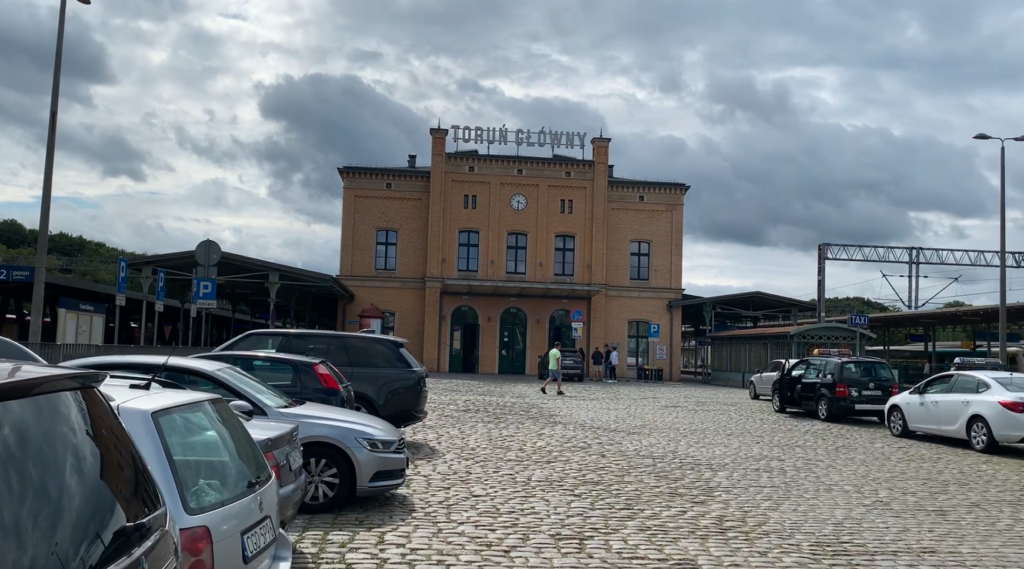
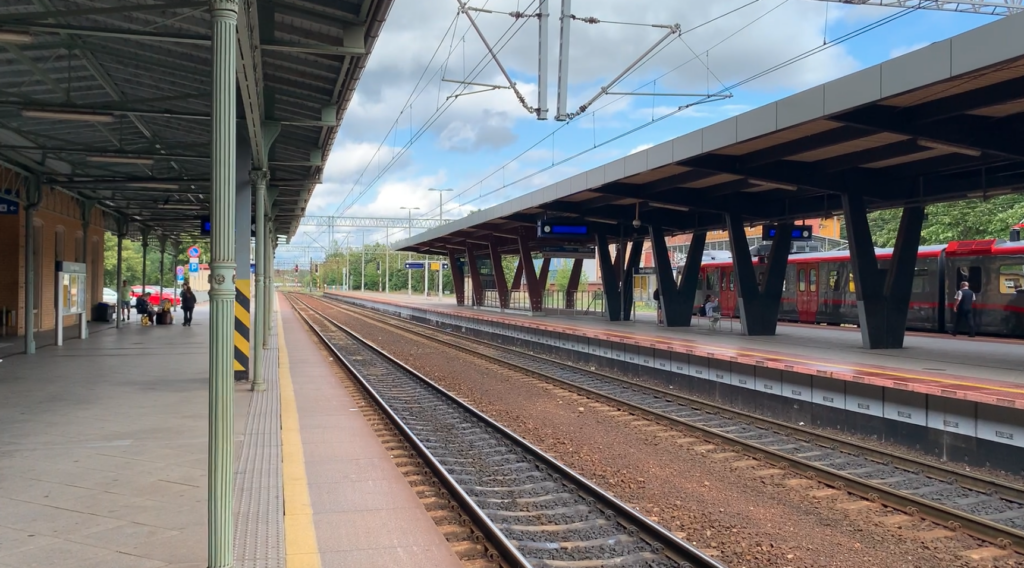
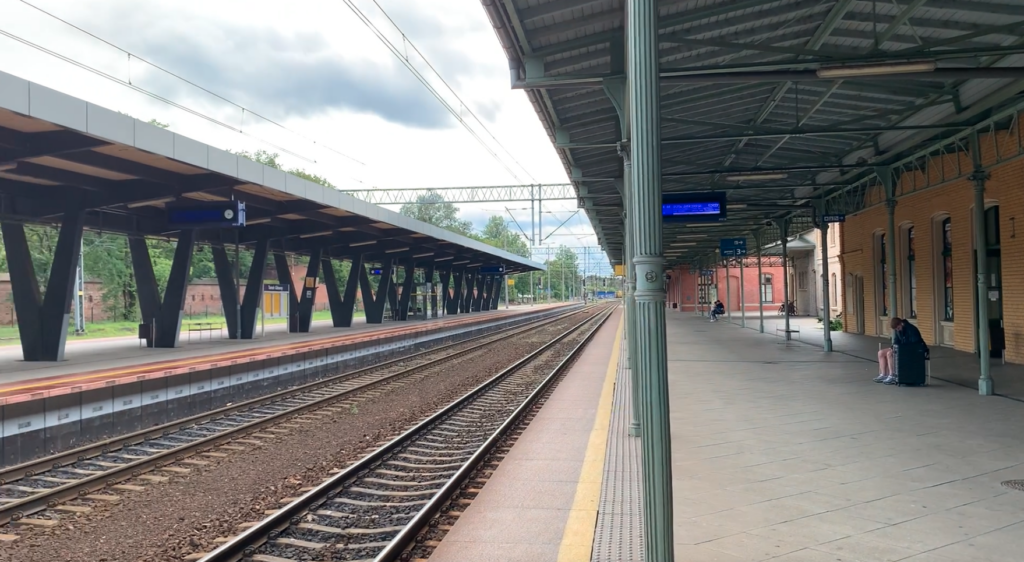
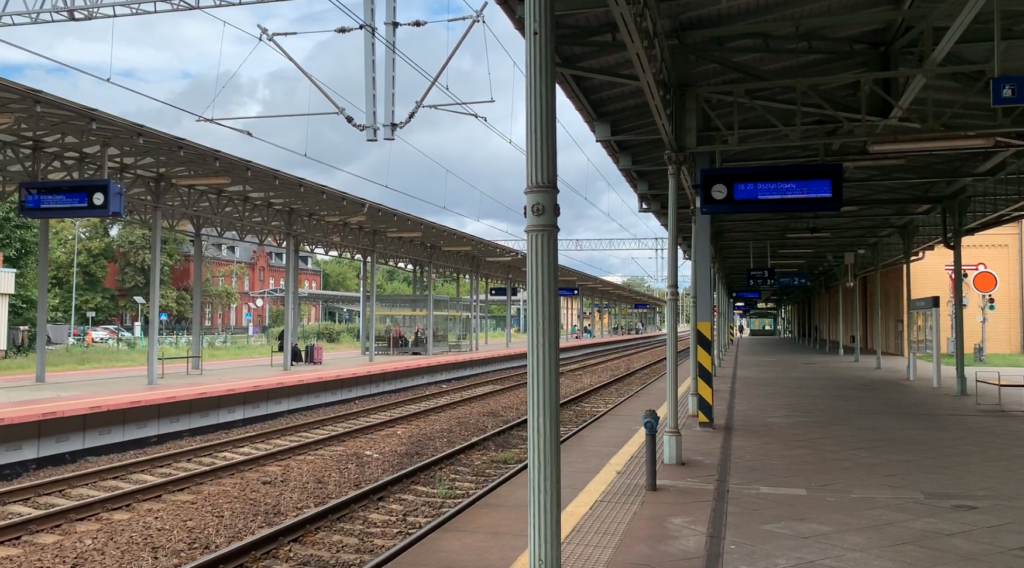
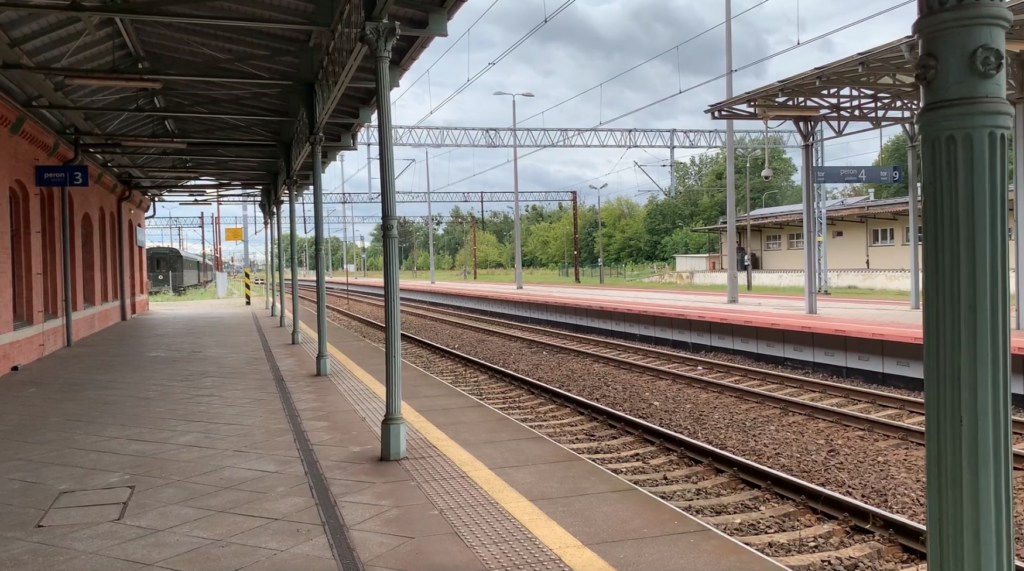
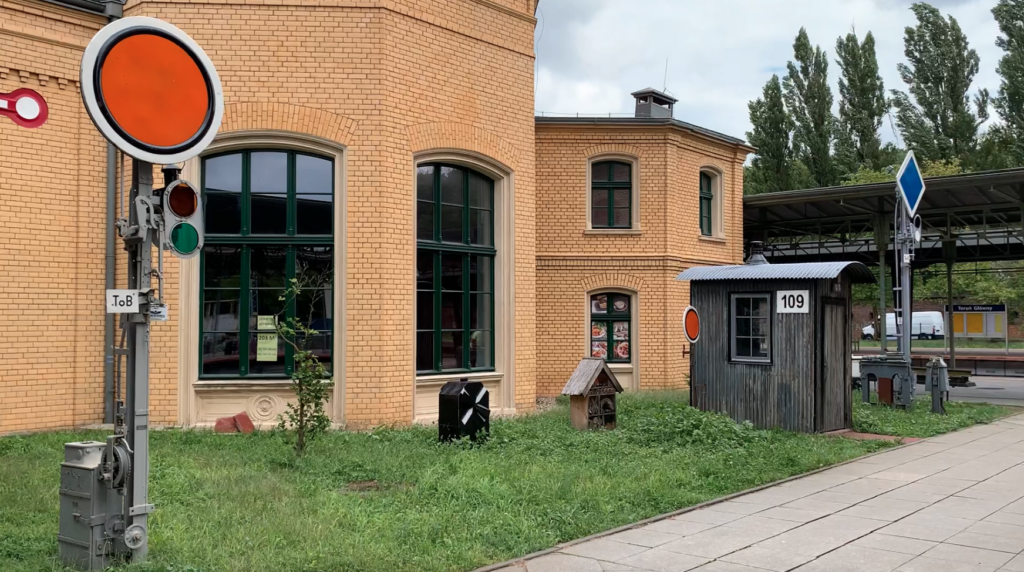
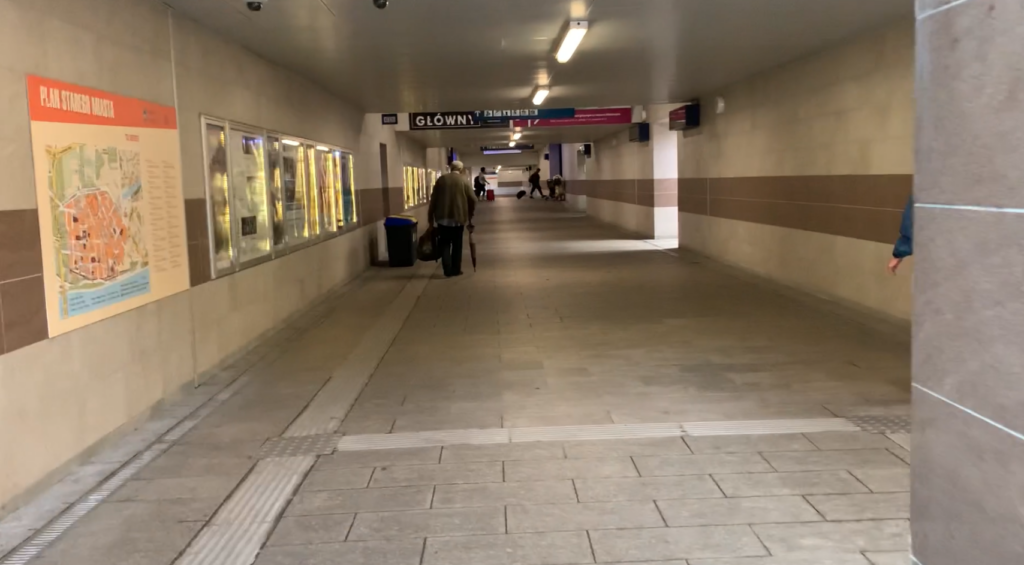
The city of Toruń.
The Slavic stronghold of Toruń was built in the 9th century. The reason for its creation was a convenient place for crossing the Vistula. These areas were inhabited by a Slavic tribe – the Lusatians. Toruń found itself on the “Amber Road”. Initially, the stronghold of Toruń was surrounded by wooden and earthen ramparts. Its main task was to protect the crossing over the Vistula.
After the Teutonic Knights were brought to Poland, Toruń became their base of operations against the Prussian tribes. Improper construction work carried out by the Teutonic Knights caused the stronghold to be repeatedly flooded by the high wave of the Vistula. As a result, in 1236, the city was moved to nearby hills, slightly upstream. Toruń received its first city rights in 1233. The city developed quickly and received new rights and privileges. In 1280, the city became a member of the Hanseatic League. Due to the aggressive actions of the Teutonic Knights, the Polish rulers built a new city towards the east. In 1454, both cities were merged. The walls separating the cities from each other remained for a long time.
At the beginning of the 15th century, Toruń already had about 20,000 inhabitants. In 1454, an uprising against the Teutonic Knights broke out. The Prussian Union was at the forefront of the uprising. The Teutonic castle was destroyed and the Thirteen Years’ War began. Toruń was incorporated into the Republic of Poland. Toruń financially supported the Polish king. As a result, the city had a privileged position, similar to Gdańsk and Elbląg. In 1528, a new mint was established, which replaced the city and Teutonic mints. Unfortunately, the Reformation came to the city, which found fertile ground here. The city was first Lutheran, and then became a center of Protestantism. The effects of these activities are still visible today. In 1568, the Academic Gymnasium was opened, which in 1594 was raised to the status of a semi-higher school, one of the first in the Republic of Poland.
The city developed dynamically, but from the second half of the 17th century, there was a time of weakening of the city, due to the ongoing wars. In 1629, the city repelled the first siege of the Swedes, but eventually surrendered. The city was recaptured from the Swedes in 1658, by the troops of King John Casimir. However, the Swedes did not retreat and severely shelled the city. The population in the city was decimated by enemy attacks and the plague epidemic. In 1772, after the first partition of the Republic of Poland, Toruń remained with Poland. However, the increasingly strong Prussian influence demanded the creation of the free city of Toruń. The second partition of Poland incorporated Toruń into Prussia. The city’s population fell to 6,000 thousand. By virtue of the Treaty of Tilsit of July 7, 1807, Toruń found itself in the Duchy of Warsaw. In the period 1813-1815, the city was occupied by the Muscovites. In 1871, the city was declared a first-degree fortress and surrounded by numerous fortifications. After the Great World War, the Congress of Vienna granted the city to the Prussians, who were here until 1920. Due to the proximity of the Prussian-Moscow border, the city could not fully develop. For example, there was a ban on building brick houses outside the city limits. Toruń was more of a fortress than a city. There were more soldiers than civilians.
The railway in Toruń was launched in 1861. The first railway line was led from Toruń to Bydgoszcz and Warsaw. In 1873, a railway bridge over the Vistula was opened. Toruń became an important railway junction. In 1899, the first electric tram was launched, and then a gasworks and a municipal power plant were launched.
The Treaty of Versailles granted Toruń to the Republic of Poland. The Germanic troops left Toruń a few weeks before January 18, 1920. Germanic civilians did not want to leave, believing that the Republic of Poland was a seasonal state. After the victory of the Polish Army over the Bolsheviks, the last hopes for the liquidation of the seasonal state vanished. The rest of the Germans, who belonged to Germania in spirit and body, left Toruń. As a result, throughout the period of the Second Republic, there was no shortage of apartments in the city. Despite this, a large percentage of autochthons remained in Toruń, who agreed to function in the Republic of Poland. Many Polish citizens came to Toruń, mainly from the overpopulated Lesser Poland. A large number of demobilized soldiers also arrived, who linked their future with Toruń.
Toruń had its own unusual character. In addition to the historic Old Town, there were many tenement houses built of half-timbered walls in the city. Generally ugly. There were also many Prussian villas with small turrets and stained glass windows, with walls decorated with stucco. The villas were surrounded by well-kept gardens with lots of trees, bushes and flowers. There was a lot of greenery in Toruń. The city did not feel suffocated in the dense development, because the streets were wide. Communication was well organized.
The city began to develop very dynamically. In 1921, it already had over 37,000 inhabitants, 90% of whom were Polish citizens. Polish banks, manufacturing plants and craft workshops were opened. In 1933, a metal road bridge over the Vistula was opened. The University of Toruń was planned to be opened in 1940, as a branch of the Adam Mickiewicz University in Poznań. In 1938, Podgórze (left bank of the Vistula) was incorporated into the city. In 1939, Toruń had 80,000 inhabitants.
On September 7, 1939, the Germans entered Toruń. The city was incorporated into the Reich, as the land of Gdańsk, West Prussia. The German occupation was a systematic extermination of the Polish population. In one action alone, over 1,000 people were captured and murdered in the surrounding forests. The Germans murdered the largest number of people in the Barbarka Forest. Four resettlement camps were established in nearby towns, later converted into penal camps. At least 3,000 people passed through these camps. The extermination was so extensive that by the beginning of 1940, there were only 15,000 Polish citizens left in Toruń.
On February 1, 1945, the Soviets marched through Toruń. The city’s monuments were lucky, because the Germans had previously withdrawn to the line of the Pomeranian Wall. The Germans still hoped that after the war the borders would remain as they were in 1938. The communists took over the city, arguing that they had a large number of workers. As a result, the city was deprived of the administration typical of the city structure (press, radio, libraries, school board, cultural associations, etc.). In 1945, Nicolaus Copernicus University was established. Several factories of the chemical, textile, electrical, metal and food industries were launched. Several of them have pre-war roots.
Toruń Główny Railway Station.
Toruń Główny Railway Station is the oldest and largest station in Toruń. The station was launched in 1861 and was located in the Stawki hamlet and the former settlement of PiaskiWielkie. The name “Stawki” comes from the existing water pits in this area, created as a result of the extraction of Pliocene clays. Currently, it is part of the Podgórze district. This is the left-bank part of the Vistula. The first name of the station was the Germanic name Thorn. The station was built together with the construction of the Bydgoszcz – Toruń – Warsaw Railway Line, which was part of the Warsaw – Bydgoszcz Railway. Initially, the station was managed by the city of Toruń.
Toruń Główny Station is located; On LK No. 18 at its 109th km. On LK No. 353 Poznań East – Skandawa at 135 km. On local LK No. 734 Nieszawka – Toruń Towarowy and 735A Toruń Główny – Toruń Podgórz.
The station has four platforms and seven platform edges. In 2022, the station served over 2 million passengers. In September 2024, 122 trains departed from Toruń Główny station to the following stations: Bydgoszcz Główna, Chełm, Chełmża, Czernikowo, Gdynia Główna, Gniezno, Gorzów Wielkopolski, Grudziądz, Inowrocław, Jabłonowo Pomorskie, Kaliska Kujawskie, Katowice, Kraków Główny, Kutno, Lublin Główny, Łódź Fabryczna, Łódź Kaliska, Mogilno, Olsztyn Główny, Piła Główna, Poznań Główny, Rzeszów Główny, Sierpc, Szczecin Główny, Szczecinek, Toruń Wschodni, Tychy, Warszawa Wschodnia, Warszawa Zachodnia, Włocławek, Wrocław Główny, Wyrzysk Osiek, Zakopane, Zielona Góra Główna.
The passenger tunnel connects the neighboring streets on both sides of the station; Kujawska Street and Podgórska Street. Light semaphores are used throughout the station. The station is electrified with 3 kV DC.
Toruń Główny Railway Station.
The first station building was put into use in 1865. The building stands to this day (2024), at Dybowska / Kujawska 15 Street. The building has two storeys and a basement. The building is covered with a gable roof, with a small slope and has two swallows. The walls are made of half-timbered brick. The first renovation of the station related to its reconstruction was carried out in 1875. Currently, the building is a residential block. The building is entered in the register of the municipal list of monuments, under No. 2184. In the square in front of the building, in the period 1934-1939 and 1950-1984, a tram terminus operated.
The new station was built in 1875. The station was built as an island station in the middle of the tracks. The same was done in Piła, Poznań and other cities. The building is rectangular in base, and the main entrance is located at the top of the eastern facade. The main wall is five-axis with a projection. The projection is topped with two small turrets. Three doors lead to the building, which are finished with arches. The windows are large. A large analog clock with a white face is placed at the top of the front. A large illuminated inscription; Toruń Główny is placed above the roof. In front of the building is the station square, which has a preserved cobblestone surface. The station is built of yellow brick. The layout of the rooms in the building is the same as in the station building in Piła. There is a hall with ticket windows, a waiting room, and railway service rooms. From the hall there is an entrance to the tunnel for travelers. At the back of the building were representative rooms for the Germanic authorities, which were later converted into a Class 1 travelers’ restaurant.
Behind the station building there is another building in which there was a telegraph and a telephone switchboard. Currently, the building houses the SOK (Railway Protection Guard) facility and toilets. The third building was the post office, which is now the Railway Memorial Room and a hostel for 60 people. Behind the building are impassable holding tracks. In 2023, on one of the tracks, behind the fence, a historic train was placed with a steam locomotive Ol49-3 and four passenger cars from the 40s of the 20th century, which were used in PKP until the end of the 60s.
Renovation of Toruń Główny station. 2014-2015.
In 2013, the Toruń City Office announced a tender for the renovation of the station. The contract with the contractor was signed in October 2013. In January 2014, Toruń Główny station was transferred by PKP PLK as property to the city office. In February 2014, work began. On November 12, 2015, the grand opening took place after the renovation. The investment cost PLN 43.5 million. The station has been deprived of barriers for disabled people. The station has an information point, a buffet, a waiting room, ticket offices, luggage storage, toilets. Escalators were installed in the station to the tunnel and to the first floor, as well as to the bus station on Kujawska Street. The rest of the places received elevators.
As part of the renovation, the elevation was renovated and the brick walls were exposed. The former post office building was transformed into a hostel for 60 people. The platforms have been renovated. The roof on each platform has been renovated. The passenger tunnel has been renovated. The tunnel has been widened and the missing part has been added to Podgórska Street. Passengers have access to bus stops on both sides of the station. Elevators and escalators have been installed. The station is equipped with a passenger information system, sound systems, electronic displays with train arrivals and departures and the public transport timetable. A new “park & ride” car park has been built on Kujawska Street. There are also charging stations for electric cars. There are two taxi ranks at the station; on the station square and on Kujawska Street. Two covered bicycle parking lots have been built for cyclists.
On March 22, 2017, the Toruń City Office signed a contract with Urbitor for the management of the station for a period of 10 years. The station is entered in the municipal register of monuments under the number 2185. On March 21, 2017, the Railway Tradition Chamber was opened in the former post office building.
Railway infrastructure.
The railway infrastructure in Toruń is very extensive. In the eastern part of the station there is a railway siding with a ramp, which is still in use. In the eastern head of the station there is a rail-road crossing, which is on DW No. 585 and connects Podgórska Street with Rudacka Street. At the crossing there is one of the railway signal boxes. In this area there is a switch, which separates LK No. 18 towards Włocławek from LK No. 353 towards Jabłonowo Pomorskie. The track layout allows trains to depart in any direction from any platform. However, in principle, the tracks at platforms 1 and 2 are used by trains towards Jabłonowo Pomorskie, and the tracks at platforms 3 and 4 towards Włocławek. Closer to the passenger station, under the railway viaducts, there is a street (Podgórska and Kujawska), from which there is a crossroads leading to the station square. On the slope, in the space between the tracks, there is a railway signal box. The western head of the passenger station has additional holding tracks. In this area, under the railway viaduct, there is a street on the DK No. 15 route, with moderate traffic. However, until 2000, it was DK No. 1 with heavy traffic, because it led to the only wheeled bridge in Toruń. Behind the viaduct, the freight part of the station in Toruń begins. On the northern side, there is a railway maintenance plant. On the southern side, there is a fuel depot, which uses old railway coal entanglements. The freight station previously had 38 tracks, most of which are currently used. The western head of the station is the Toruń Kluczyki station. Here, too, there were workshops, warehouses, a coal depot, a cleaning channel and others. The station currently houses a modern rectangular locomotive shed. There is also the PKP Cargotabor Zakład Północny plant. Two unused turntables remained after the dismantling of two fan locomotive sheds. There are holding tracks for EZTs, which are in active passenger traffic. The Toruń Kluczyki passenger stop is open. In the western part of the station there are turnouts of two main double-track railway lines No. 18 and No. 353, which have many possibilities for conducting traffic.
There are two unused water towers at the Toruń Kluczyki station. One is round brick. The second tower, also brick, was built in the period 1941-1943 (German occupation) and has an unusual appearance. The tower stands at Akacjowa Street 19. The tower was built by British and Soviet prisoners of war. The tower served up to 100 steam locomotives per day. Around 2000, the tower was rebuilt into a residential block and is also a location for mobile phone antennas. The building is entered in the municipal register of monuments under No. 2202.
Toruń Główny platforms.
There are four platforms at the station. They are numbered from the south. Platform 1 is an island platform. The platform is 400 m long. There is a modern roof on the platform, 175 m long. Platform 2 is single-edged and has a historical roof. The wooden roof is supported on cast iron pillars. The platform is 360 m long and the roof is 185 m long. Platform 3 is single-edged and is 373 m long and has a historical roof of 175 m long. In the eastern part of the platform there is also an additional impassable track for trains heading to Włocławek or Jabłonowo Pomorskie. Platform 4 is an island platform and is 400 m long and has a roof of 175 m long. The roof is a spatial structure made of steel and the roof is transparent. The bus stops on the northern side of the station are of a similar construction.
Military.
There are many former military facilities near the Toruń Główny station. On the south side is the Przyczółek Mostowy Fort. Currently, it is a green area; Tysiąclecia Park. North of the station, there are also green areas; Kępa Bazarowa Nature Reserve. Here, there is the Mała Wisełka River and the Vistula River. East of the station, there is the Railway Fort. The Toruń Główny – Jabłonowo Pomorskie railway line was particularly fortified, together with the railway bridge over the Vistula. There are guard towers, bunkers and a tunnel, the size of which allows for only one railway track.
Written by Karol Placha Hetman
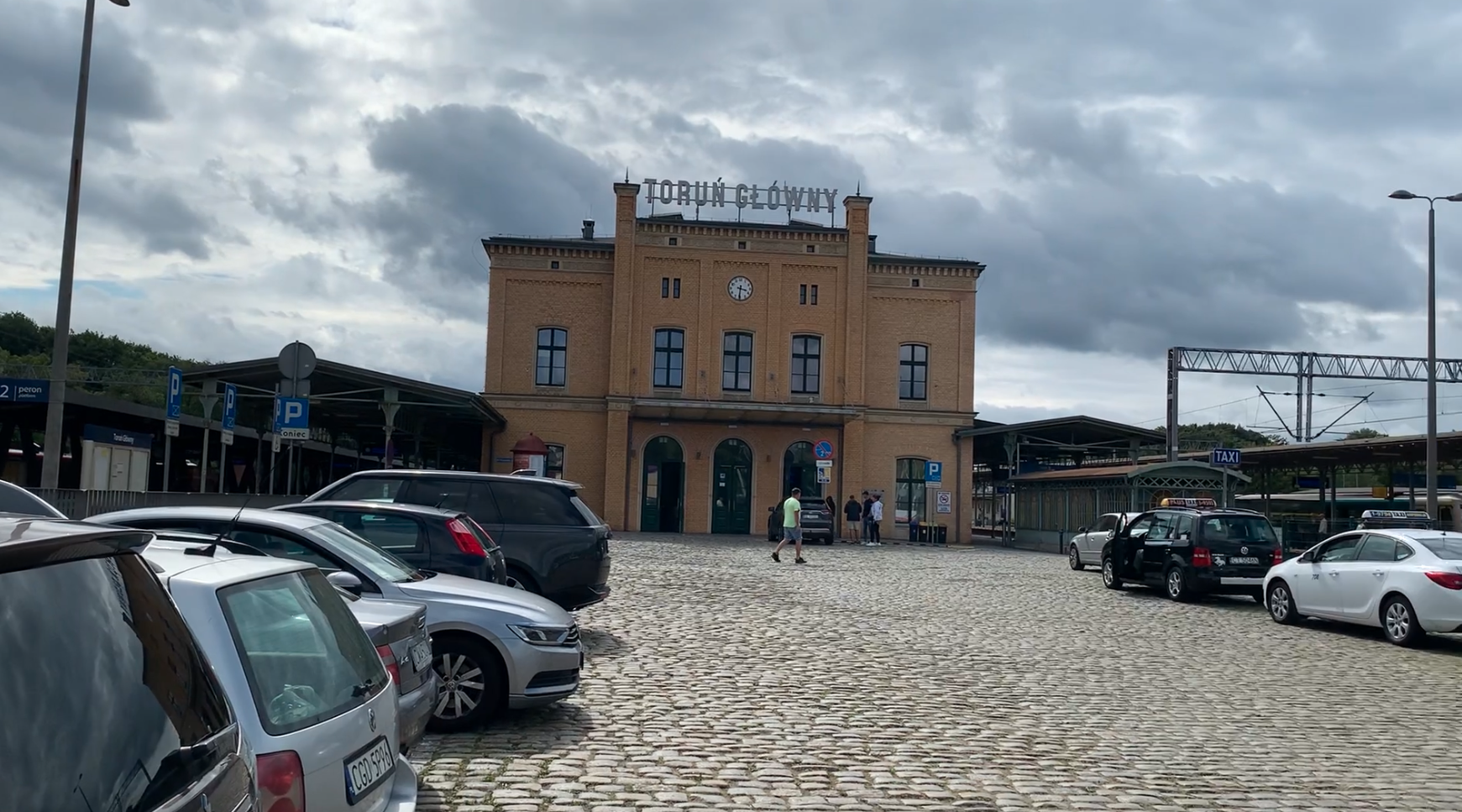
Leave a Reply
You must be logged in to post a comment.